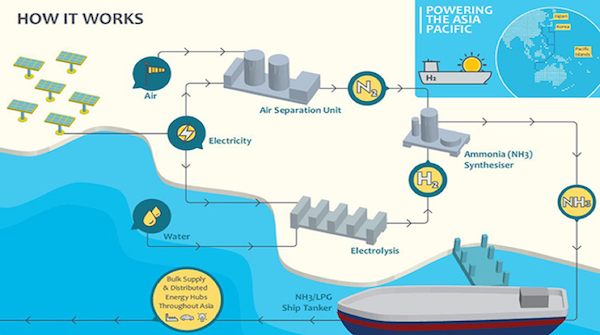Solar energy is a free source of non-polluting renewable energy that is sustainable and totally inexhaustible. Most people are aware of photovoltaics (PV), and that solar panels can be used to generate electricity and produce hot water. Now experts have developed techniques to convert sunlight into “solar fuels.” The process involves exposing water molecules to sunlight to separate the hydrogen and oxygen atoms, and then combining the hydrogen with carbon dioxide to create liquid fuels. The generated hydrogen can also be condensed (under pressure at very low temperatures) into liquid hydrocarbon fuels (LH2), simple hydrogen gas, and metal hydride, or converted to methanol.
Another well-established technique is to combine hydrogen with nitrogen to make ammonia, which can then be compressed into a liquid at much more moderate temperatures, and is relatively easy to transport. The process is depicted in the following diagram.
Credit: CSIRO
Liquefied hydrogen can be used in much the same way as gasoline and diesel, or it can be used in fuel cells to generate electricity. Solar fuels would enable solar energy captured during the day to be stored, transported, and used when the sun’s not shining. In addition, such fuels would provide all the advantages of conventional fossil fuels along with the environmental benefits of renewable energy — a key step in someday powering cars with the sun. Research in solar-derived liquid fuels, aims to make a range of products that are compatible with today’s energy infrastructure, such as gasoline, jet fuel and hydrogen. Imagine a solar panel but, instead of wires with electricity coming out of it, it would have a pipe carrying fuel that can power your vehicle.
Bill Gates recently launched Breakthrough Ventures, a $1 billion fund to invest in scientific discoveries that have the potential to deliver cheap and reliable clean energy to the world. Gates believes solar fuels can be an “energy miracle,” as it would help overcome challenges to renewable energy adoption while producing dramatic reductions in greenhouse gas emissions. Done economically, this represents a huge step toward overcoming the two major obstacles in shifting from fossil fuels to renewable energy: namely, storing large amounts of energy for later use, and powering forms of transportation that cannot easily run on batteries. Australia-based CSIRO recently announced the establishment of a pilot plant to test technology that can refine a 100% pure stream of hydrogen from gasified ammonia.
Producing Renewable Hydrogen Fuel with Solar Energy
Hydrogen itself isn’t actually a fuel — it’s an energy carrier, and regarded by some as the energy source of the future. It is produced by splitting water molecules (H2O) into hydrogen and oxygen through a process called electrolysis. The hydrogen is then stored and can be used in a fuel cell to produce electricity when no sunlight is available, or can be converted into transportable LH2 for export.
The future of hydrogen is bright. Since it doesn’t emit carbon dioxide when burned, hydrogen is potentially the ultimate source of clean energy, and opening up a whole new energy market by using it to export solar power. Australia is set to be the first to do the latter after signing a deal with Japan to ship liquid hydrogen in bulk from Victoria.

Artist’s impression of a liquid hydrogen carrier from ship-builder Kawasaki Heavy Industries. Credit: Kawasaki Heavy Industries
Hydrogen-fueled cars have the added advantage of potentially taking far less time to refuel — as little as five minutes with compressed high pressure gas — compared to an electric vehicle, which might need more time to recharge.
Conclusions
India is blessed with unlimited amounts of sun and has an enormous capacity to generate renewable energy compared to other countries. Solar fuels have the potential to turn India into a renewable energy superpower. Solar fuel could be the key to meeting future demands for sustainable energy, with emerging technologies enabling us to harness and convert sunshine into an array of useable fuels.
Germany is rapidly scaling up R&D in technologies that use electricity from solar or wind power to electrolyze water to produce hydrogen (and oxygen). Japan has announced an energy plan that includes support for hydrogen fuel cells in homes, cars, large scale power plants, and industrial processes. Saudi Arabia also has plans to export up to 10 GW of solar fuels to Europe.
Like these other countries, India must begin to actively embrace the potential of solar fuels as a clean alternative fuel source — and an export. This is a great opportunity for India to create a solar industry which is not limited to the scale of its electricity network, but allows exporting their sunshine around the world. Like LNG in the 1970s, when technology allowed natural gas to be liquefied and transported, I can imagine India bottling and shipping sunlight as renewable hydrogen on an industrial scale around the world.
Lead image credit: depositphotos.com














